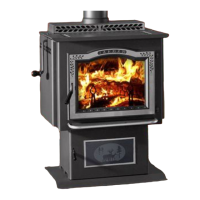12
Do not burn any fuel other than wood, such as
charcoal, which can cause increased carbon monoxide
production or overfiring. Never use highly volatile
substances in your stove, such as gasoline, which could
cause an explosion.
When solid fuels are burned completely, they produce
water and carbon dioxide. However, in long slow
burns, a substantial amount of carbon monoxide may
be produced. If allowed to build up, carbon monoxide
(which is odorless) can prove fatally poisonous. Proper
ventilation and draft will prevent this from happening. If
you smell smoke, turn up the air control lever setting,
and thoroughly ventilate your dwelling. During future
burns, be careful not to overload the stove with fuel, so
you will not be tempted to constantly operate at a low
air control setting.
Other causes of poor ventilation or draft are icing,
exhaust fans, a blocked outside air inlet, and room
air starvation. If your stove is sluggish and you get
occasional odor, check these possibilities and increase
the air ow in your home.
When venting your TL300 using a prefabricated
chimney, be sure to contact local building code
authorities, and to follow the manufacturer’s
instructions exactly. Use only the manufacturer’s
parts; do not use makeshift installation techniques. All
prefabricated chimneys must be tested to either the
U.S. or Canadian high-temperature standards, UL 103
or ULC S629.
If you plan on using a pre-existing masonry chimney,
have it thoroughly inspected and cleaned. Any faults
which make the chimney unsafe and unusable must be
repaired prior to use. These can include improper height,
structural defects, blockages, inadequate clearance to
combustibles, unsealed openings into other rooms of
the house, signs of creosote or smoke leakage, a loose
or absent clean-out door, or absence of a liner.
When connecting to a masonry chimney, several
provisions are standard. First, whether the chimney
connector is vented to the chimney through a thimble
or a breech pipe, neither must pass beyond the inner
surface of the chimney liner, and both must be rmly
cemented in place with refractory cement. (A thimble is
a masonry pipe which is inserted through the chimney
wall, and is frequently the preferred method; a breech
pipe is a piece of steel pipe used the same way.) In
Canada, a breech pipe has ridges or protrusions to lock
it rmly into the refractory cement. In either case, the
chimney connector vents to the chimney through the
thimble or breech pipe.
Using a thimble, the connector slides completely
inside the masonry to the inner edge of the ue liner,
and may be easily removed for chimney and connector
inspection. A breech pipe must extend at least 2" (50
mm) into the room, so the connector can be attached
with sheetmetal screws.
In some situations, a code compliant chimney origi-
nally used for a masonry replace may be used to install
your TL300. In addition to the requirements found in
the previous paragraphs, it is important to be aware
that all clearances must be met, including those from
the chimney connector to combustibles. Do not forget
to include oor protection in your plans. (See Clear-
ances and Floor Protection in this section.) Since many
replaces have exposed wooden mantels and trim, pay
special attention to the clearances necessary to these
materials.
If your replace chimney is behind a combustible wall,
you must use an approved wall pass-through system
to gain access to the masonry chimney. The chimney
connector must enter the chimney at a place where it
is lined, and the replace must be made inoperable.
For example, you might remove the damper, replacing
it with a secure, airtight, noncombustible seal (remov-
able for inspection); this also satises the requirement
that no room air must be allowed to enter the chimney.

